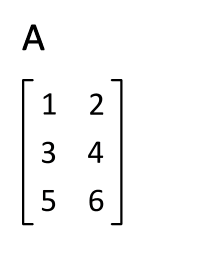Transpose
Transpose refers to the operation of changing the order or position of elements within a mathematical matrix or a data structure. In the context of mathematics, to transpose a matrix means to flip a matrix over its diagonal, turning the matrix's row into columns and vice versa. This operation is fundamental in various areas of mathematics, linear algebra, computer science, and related fields, playing a crucial role in solving linear equations, transforming coordinate systems, and manipulating data in programming.
Definition[edit | edit source]
Given a matrix A of dimensions m × n, where m is the number of rows and n is the number of columns, the transpose of A, denoted as AT or sometimes A', is a new matrix AT of dimensions n × m where each element aij in A is mapped to aji in AT. This means that the first row of A becomes the first column of AT, the second row of A becomes the second column of AT, and so on.
Applications[edit | edit source]
Transpose operations are widely used across different fields:
- In linear algebra, the transpose is used in the calculation of a matrix's determinant, in finding inverse matrices, and in the definition of symmetric matrices and orthogonal matrices. - In computer science, transposing data structures is a common operation in algorithm design and optimization, especially in the manipulation of arrays, data frames, and matrices for data analysis and machine learning. - In signal processing, transposing is used in the formulation and solution of systems of linear equations, which are fundamental in the analysis and interpretation of signals.
Properties[edit | edit source]
The transpose operation has several important properties: - **Symmetry**: If you transpose a matrix twice, you get back the original matrix. Mathematically, (AT)T = A. - **Inverse**: The transpose of the product of two matrices is equal to the product of their transposes in reverse order. That is, (AB)T = BTAT. - **Addition**: The transpose of a sum of two matrices is equal to the sum of their transposes. That is, (A + B)T = AT + BT.
Transpose in Programming[edit | edit source]
In programming, transposing a matrix or an array is a common task, which can be achieved through nested loops or, in higher-level languages, with built-in functions. For example, in Python, the NumPy library offers the transpose function, which can transpose arrays of any dimension.
See Also[edit | edit source]
- Matrix - Linear algebra - Computer science - Data structure
This article is a mathematics-related stub. You can help WikiMD by expanding it!
Search WikiMD
Ad.Tired of being Overweight? Try W8MD's physician weight loss program.
Semaglutide (Ozempic / Wegovy and Tirzepatide (Mounjaro / Zepbound) available.
Advertise on WikiMD
|
WikiMD's Wellness Encyclopedia |
| Let Food Be Thy Medicine Medicine Thy Food - Hippocrates |
Translate this page: - East Asian
中文,
日本,
한국어,
South Asian
हिन्दी,
தமிழ்,
తెలుగు,
Urdu,
ಕನ್ನಡ,
Southeast Asian
Indonesian,
Vietnamese,
Thai,
မြန်မာဘာသာ,
বাংলা
European
español,
Deutsch,
français,
Greek,
português do Brasil,
polski,
română,
русский,
Nederlands,
norsk,
svenska,
suomi,
Italian
Middle Eastern & African
عربى,
Turkish,
Persian,
Hebrew,
Afrikaans,
isiZulu,
Kiswahili,
Other
Bulgarian,
Hungarian,
Czech,
Swedish,
മലയാളം,
मराठी,
ਪੰਜਾਬੀ,
ગુજરાતી,
Portuguese,
Ukrainian
Medical Disclaimer: WikiMD is not a substitute for professional medical advice. The information on WikiMD is provided as an information resource only, may be incorrect, outdated or misleading, and is not to be used or relied on for any diagnostic or treatment purposes. Please consult your health care provider before making any healthcare decisions or for guidance about a specific medical condition. WikiMD expressly disclaims responsibility, and shall have no liability, for any damages, loss, injury, or liability whatsoever suffered as a result of your reliance on the information contained in this site. By visiting this site you agree to the foregoing terms and conditions, which may from time to time be changed or supplemented by WikiMD. If you do not agree to the foregoing terms and conditions, you should not enter or use this site. See full disclaimer.
Credits:Most images are courtesy of Wikimedia commons, and templates, categories Wikipedia, licensed under CC BY SA or similar.
Contributors: Prab R. Tumpati, MD


